stop start TOYOTA COROLLA HATCHBACK 2022 (in English) Repair Manual
[x] Cancel search | Manufacturer: TOYOTA, Model Year: 2022, Model line: COROLLA HATCHBACK, Model: TOYOTA COROLLA HATCHBACK 2022Pages: 758, PDF Size: 155.26 MB
Page 345 of 758
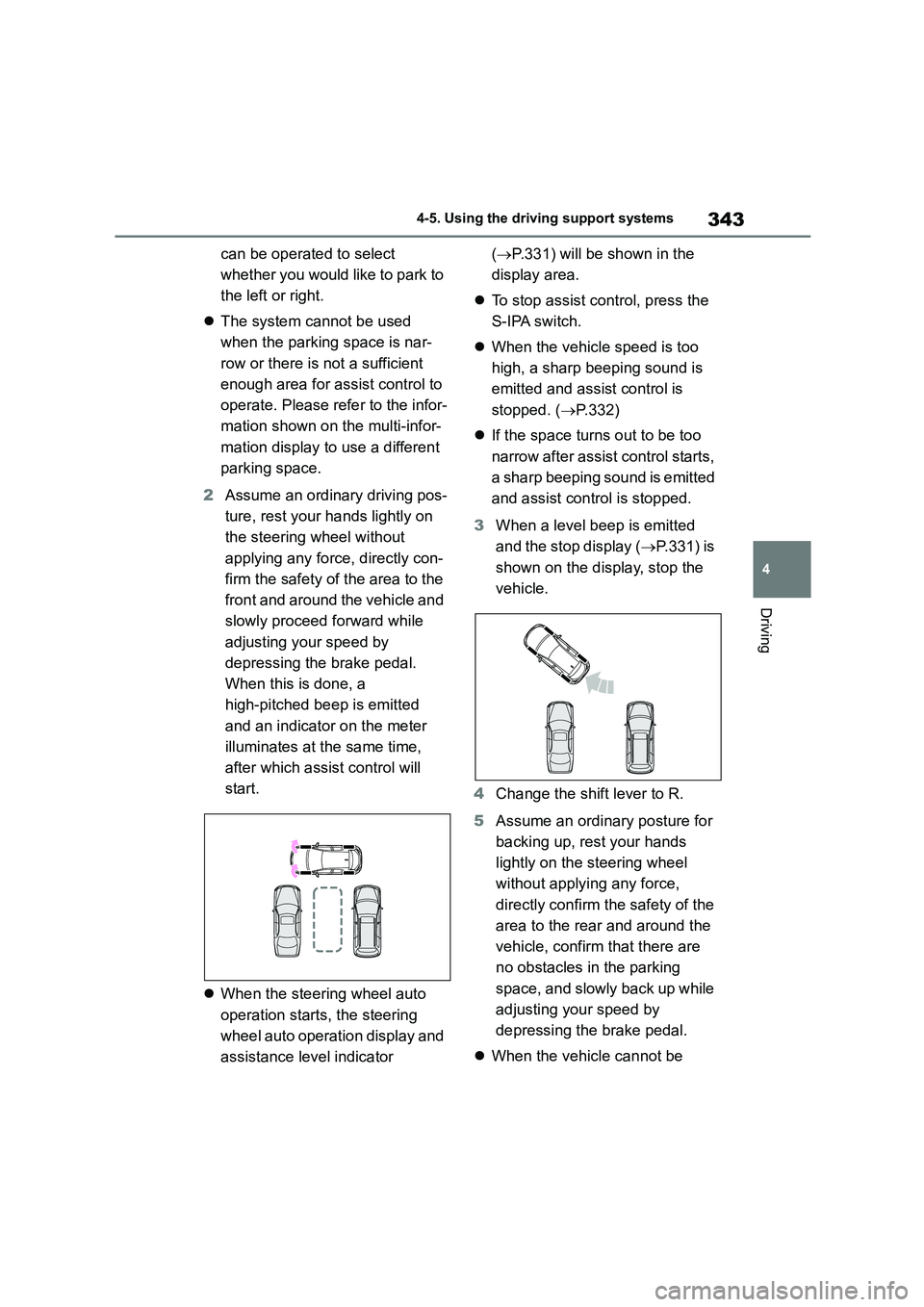
343
4
4-5. Using the driving support systems
Driving
can be operated to select
whether you would like to park to
the left or right.
The system cannot be used
when the parking space is nar-
row or there is not a sufficient
enough area for assist control to
operate. Please refer to the infor-
mation shown on the multi-infor-
mation display to use a different
parking space.
2 Assume an ordinary driving pos-
ture, rest your hands lightly on
the steering wheel without
applying any force, directly con-
firm the safety of the area to the
front and around the vehicle and
slowly proceed forward while
adjusting your speed by
depressing the brake pedal.
When this is done, a
high-pitched beep is emitted
and an indicator on the meter
illuminates at the same time,
after which assist control will
start.
When the steering wheel auto
operation starts, the steering
wheel auto operation display and
assistance level indicator
( P.331) will be shown in the
display area.
To stop assist control, press the
S-IPA switch.
When the vehicle speed is too
high, a sharp beeping sound is
emitted and assist control is
stopped. ( P.332)
If the space turns out to be too
narrow after assist control starts,
a sharp beeping sound is emitted
and assist control is stopped.
3 When a level beep is emitted
and the stop display ( P.331) is
shown on the display, stop the
vehicle.
4 Change the shift lever to R.
5 Assume an ordinary posture for
backing up, rest your hands
lightly on the steering wheel
without applying any force,
directly confirm the safety of the
area to the rear and around the
vehicle, confirm that there are
no obstacles in the parking
space, and slowly back up while
adjusting your speed by
depressing the brake pedal.
When the vehicle cannot be
Page 348 of 758
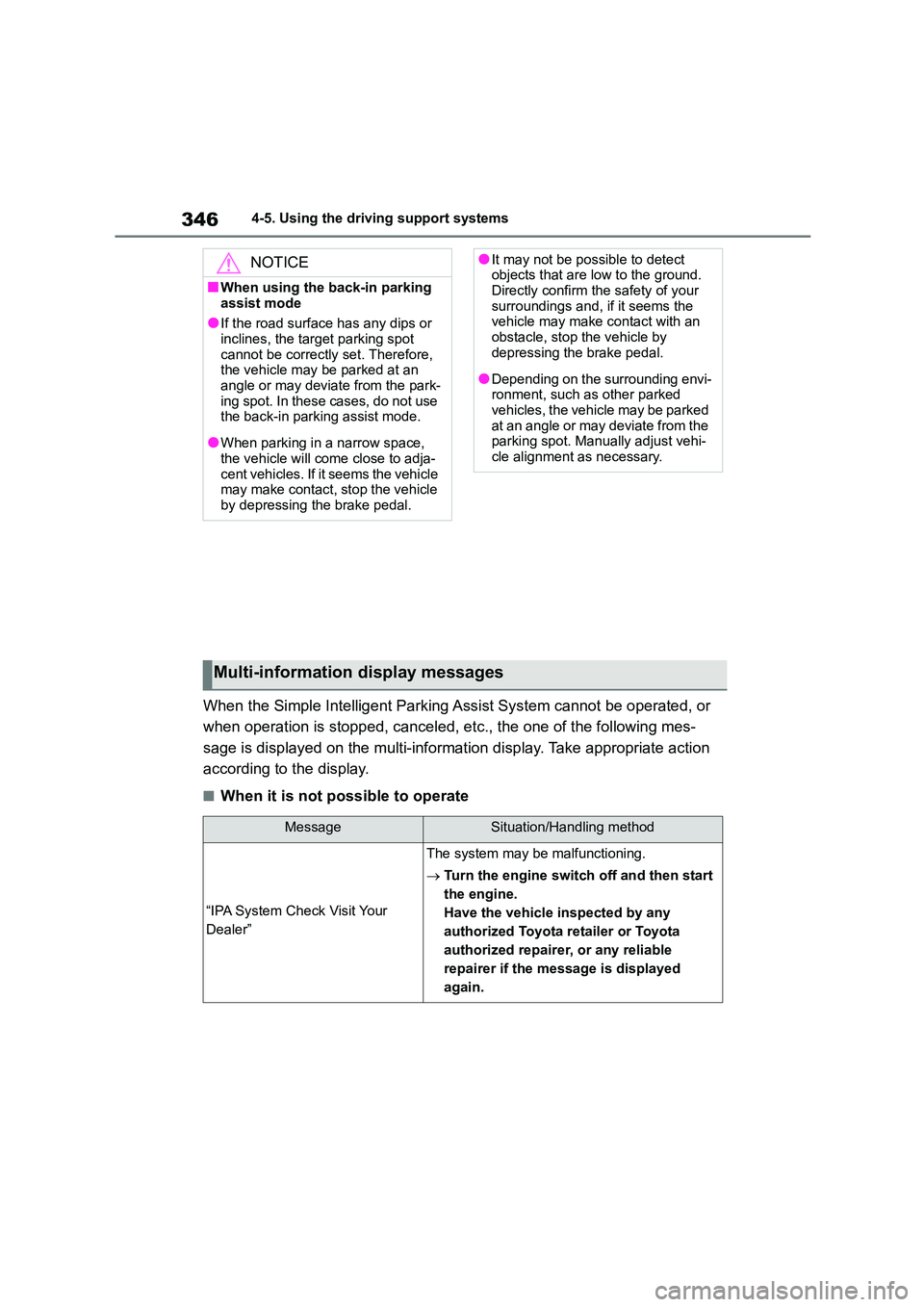
3464-5. Using the driving support systems
When the Simple Intelligent Parking Assist System cannot be operated, or
when operation is stopped, canceled, etc., the one of the following mes-
sage is displayed on the multi-information display. Take appropriate action
according to the display.
■When it is not possible to operate
NOTICE
■When using the back-in parking
assist mode
●If the road surface has any dips or inclines, the target parking spot
cannot be correctly set. Therefore,
the vehicle may be parked at an angle or may deviate from the park-
ing spot. In these cases, do not use
the back-in parking assist mode.
●When parking in a narrow space,
the vehicle will come close to adja-
cent vehicles. If it seems the vehicle may make contact, stop the vehicle
by depressing the brake pedal.
●It may not be possible to detect objects that are low to the ground.
Directly confirm the safety of your
surroundings and, if it seems the vehicle may make contact with an
obstacle, stop the vehicle by
depressing the brake pedal.
●Depending on the surrounding envi-
ronment, such as other parked vehicles, the vehicle may be parked
at an angle or may deviate from the
parking spot. Manually adjust vehi- cle alignment as necessary.
Multi-information display messages
MessageSituation/Handling method
“IPA System Check Visit Your
Dealer”
The system may be malfunctioning.
Turn the engine switch off and then start
the engine.
Have the vehicle inspected by any
authorized Toyota retailer or Toyota
authorized repairer, or any reliable
repairer if the message is displayed
again.
Page 351 of 758
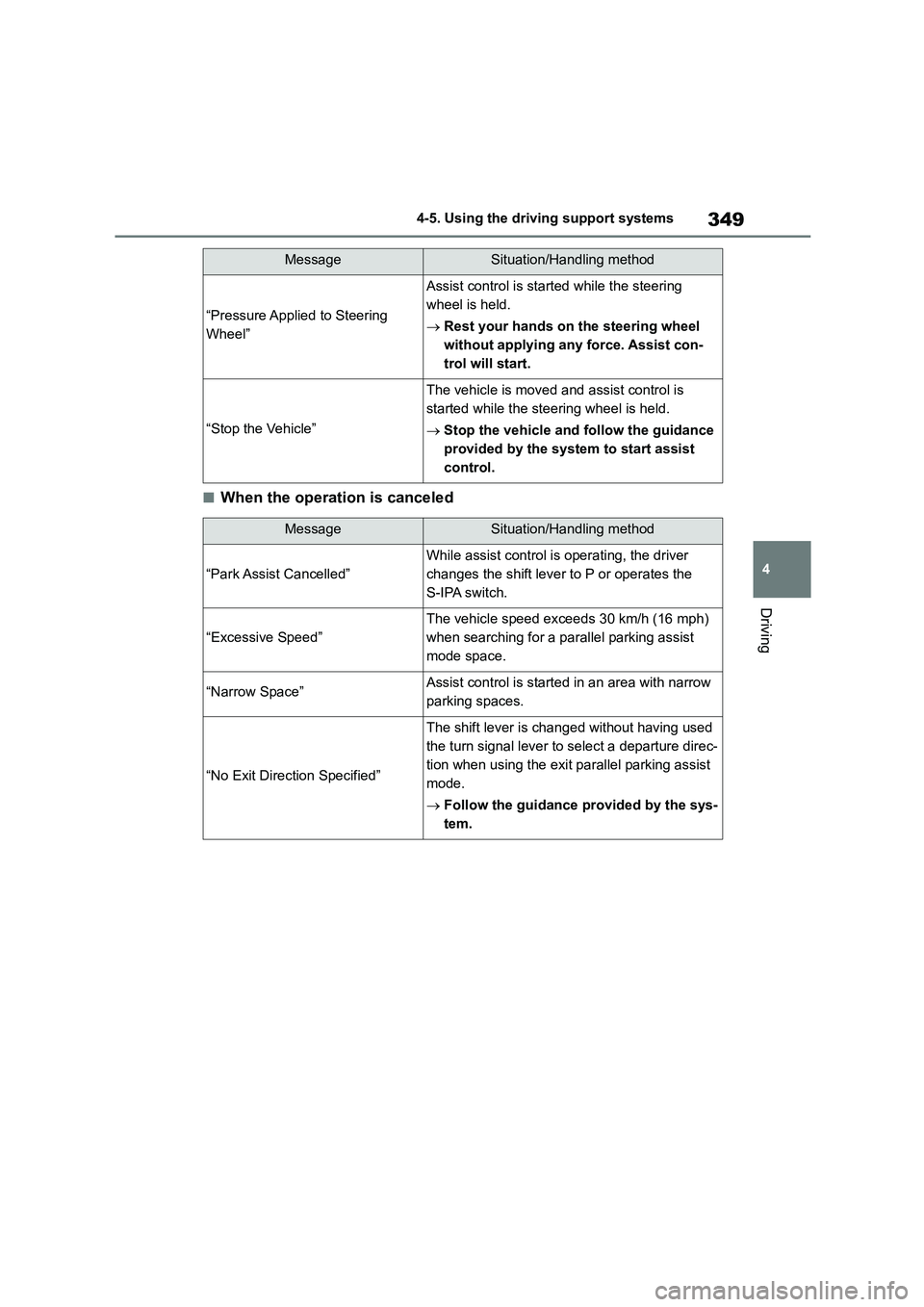
349
4
4-5. Using the driving support systems
Driving
■When the operation is canceled
“Pressure Applied to Steering
Wheel”
Assist control is started while the steering
wheel is held.
Rest your hands on the steering wheel
without applying any force. Assist con-
trol will start.
“Stop the Vehicle”
The vehicle is moved and assist control is
started while the steering wheel is held.
Stop the vehicle and follow the guidance
provided by the system to start assist
control.
MessageSituation/Handling method
“Park Assist Cancelled”
While assist control is operating, the driver
changes the shift lever to P or operates the
S-IPA switch.
“Excessive Speed”
The vehicle speed exceeds 30 km/h (16 mph)
when searching for a parallel parking assist
mode space.
“Narrow Space”Assist control is started in an area with narrow
parking spaces.
“No Exit Direction Specified”
The shift lever is changed without having used
the turn signal lever to select a departure direc-
tion when using the exit parallel parking assist
mode.
Follow the guidance provided by the sys-
tem.
MessageSituation/Handling method
Page 352 of 758
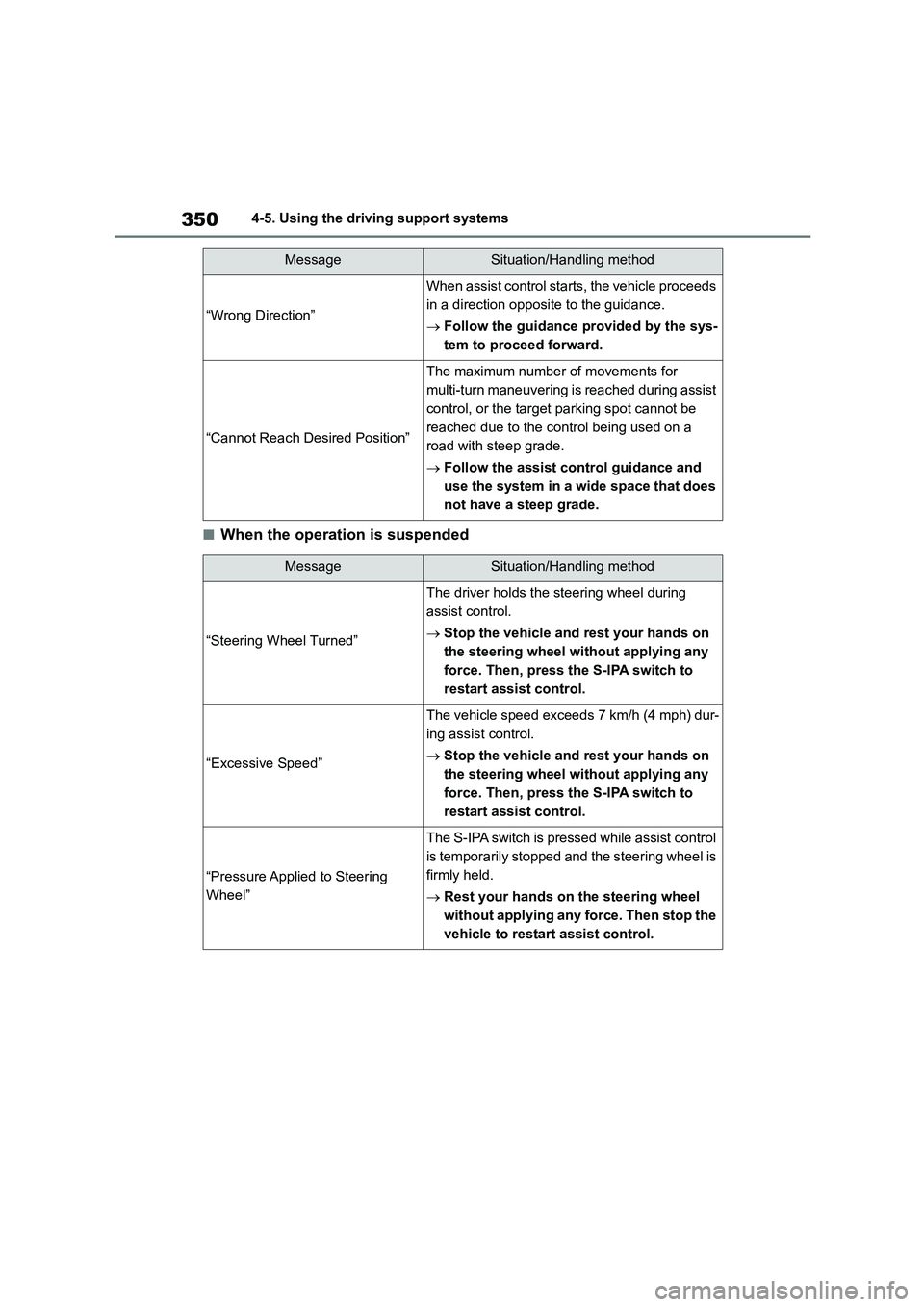
3504-5. Using the driving support systems
■When the operation is suspended
“Wrong Direction”
When assist control starts, the vehicle proceeds
in a direction opposite to the guidance.
Follow the guidance provided by the sys-
tem to proceed forward.
“Cannot Reach Desired Position”
The maximum number of movements for
multi-turn maneuvering is reached during assist
control, or the target parking spot cannot be
reached due to the control being used on a
road with steep grade.
Follow the assist control guidance and
use the system in a wide space that does
not have a steep grade.
MessageSituation/Handling method
“Steering Wheel Turned”
The driver holds the steering wheel during
assist control.
Stop the vehicle and rest your hands on
the steering wheel without applying any
force. Then, press the S-IPA switch to
restart assist control.
“Excessive Speed”
The vehicle speed exceeds 7 km/h (4 mph) dur-
ing assist control.
Stop the vehicle and rest your hands on
the steering wheel without applying any
force. Then, press the S-IPA switch to
restart assist control.
“Pressure Applied to Steering
Wheel”
The S-IPA switch is pressed while assist control
is temporarily stopped and the steering wheel is
firmly held.
Rest your hands on the steering wheel
without applying any force. Then stop the
vehicle to restart assist control.
MessageSituation/Handling method
Page 353 of 758
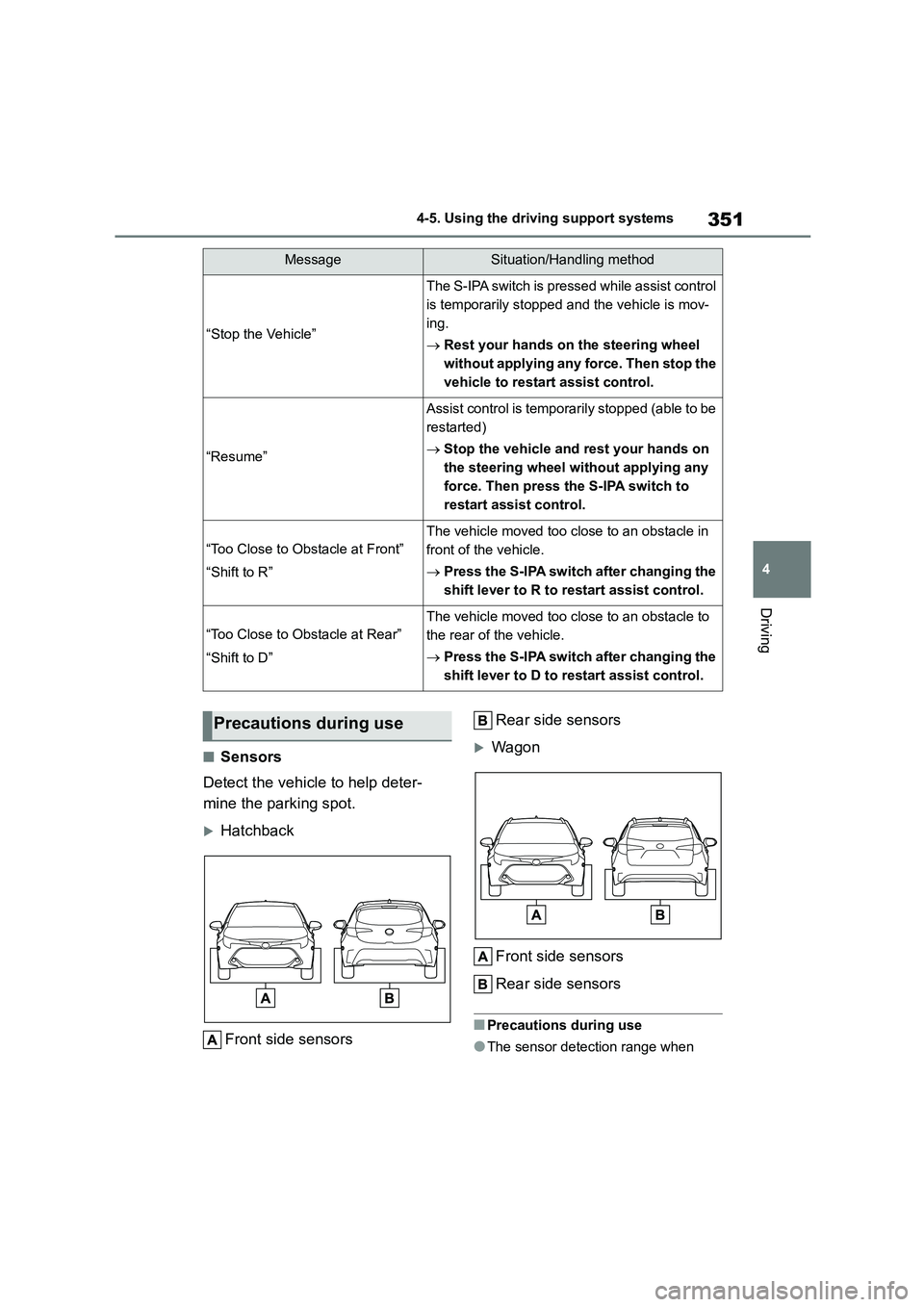
351
4
4-5. Using the driving support systems
Driving
■Sensors
Detect the vehicle to help deter-
mine the parking spot.
Hatchback
Front side sensors
Rear side sensors
Wagon
Front side sensors
Rear side sensors
■Precautions during use
●The sensor detection range when
“Stop the Vehicle”
The S-IPA switch is pressed while assist control
is temporarily stopped and the vehicle is mov-
ing.
Rest your hands on the steering wheel
without applying any force. Then stop the
vehicle to restart assist control.
“Resume”
Assist control is temporarily stopped (able to be
restarted)
Stop the vehicle and rest your hands on
the steering wheel without applying any
force. Then press the S-IPA switch to
restart assist control.
“Too Close to Obstacle at Front”
“Shift to R”
The vehicle moved too close to an obstacle in
front of the vehicle.
Press the S-IPA switch after changing the
shift lever to R to restart assist control.
“Too Close to Obstacle at Rear”
“Shift to D”
The vehicle moved too close to an obstacle to
the rear of the vehicle.
Press the S-IPA switch after changing the
shift lever to D to restart assist control.
MessageSituation/Handling method
Precautions during use
Page 359 of 758
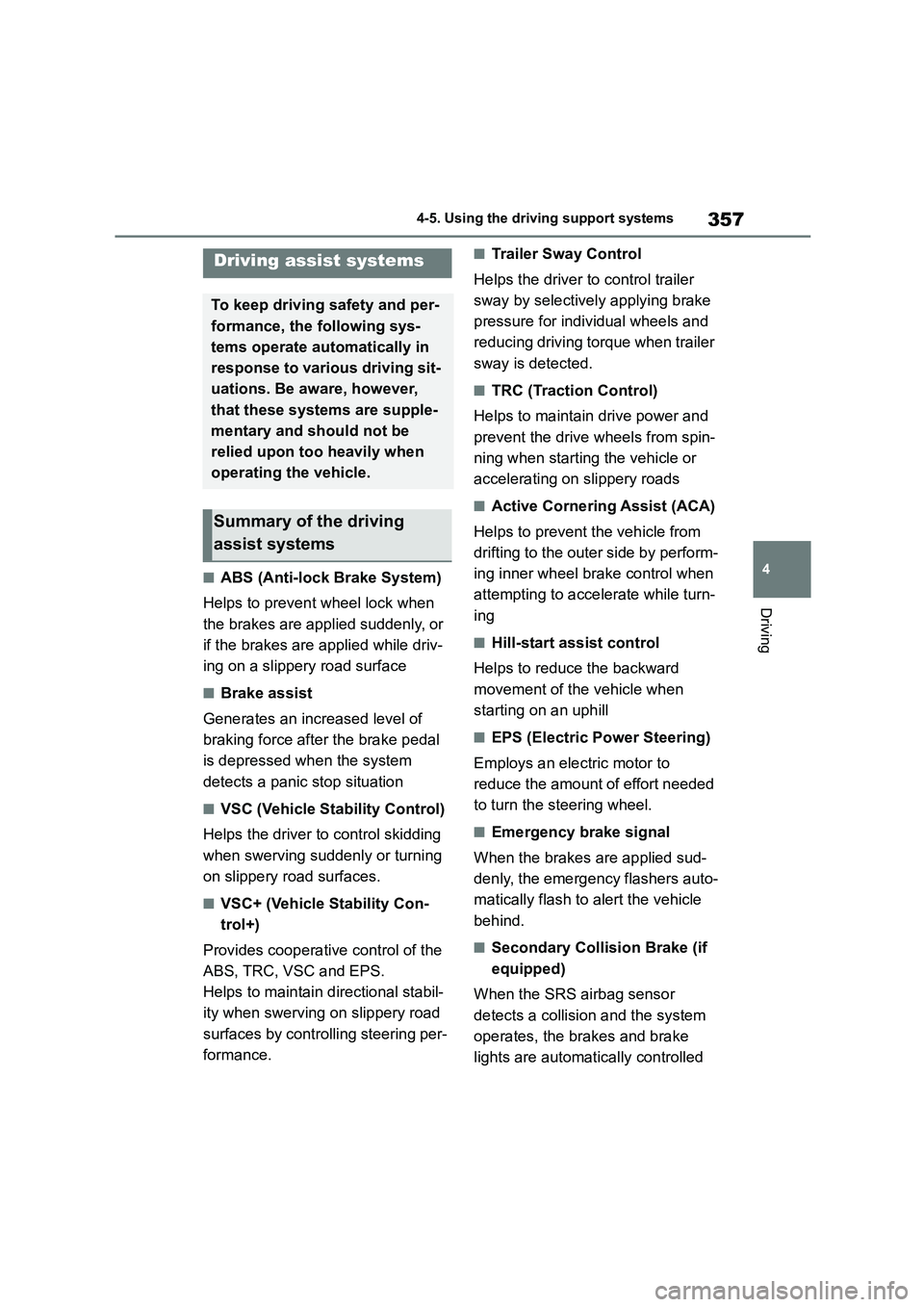
357
4
4-5. Using the driving support systems
Driving
■ABS (Anti-lock Brake System)
Helps to prevent wheel lock when
the brakes are applied suddenly, or
if the brakes are applied while driv-
ing on a slippery road surface
■Brake assist
Generates an increased level of
braking force after the brake pedal
is depressed when the system
detects a panic stop situation
■VSC (Vehicle St ability Control)
Helps the driver to control skidding
when swerving suddenly or turning
on slippery road surfaces.
■VSC+ (Vehicle Stability Con-
trol+)
Provides cooperative control of the
ABS, TRC, VSC and EPS.
Helps to maintain directional stabil-
ity when swerving on slippery road
surfaces by controlling steering per-
formance.
■Trailer Sway Control
Helps the driver to control trailer
sway by selectively applying brake
pressure for individual wheels and
reducing driving torque when trailer
sway is detected.
■TRC (Traction Control)
Helps to maintain drive power and
prevent the drive wheels from spin-
ning when starting the vehicle or
accelerating on slippery roads
■Active Cornering Assist (ACA)
Helps to prevent the vehicle from
drifting to the outer side by perform-
ing inner wheel brake control when
attempting to acce lerate while turn-
ing
■Hill-start assist control
Helps to reduce the backward
movement of the vehicle when
starting on an uphill
■EPS (Electric Po wer Steering)
Employs an electric motor to
reduce the amount of effort needed
to turn the steering wheel.
■Emergency brake signal
When the brakes are applied sud-
denly, the emergency flashers auto-
matically flash to alert the vehicle
behind.
■Secondary Collision Brake (if
equipped)
When the SRS airbag sensor
detects a collisi on and the system
operates, the brakes and brake
lights are automatically controlled
Driving assist systems
To keep driving safety and per-
formance, the following sys-
tems operate au tomatically in
response to various driving sit-
uations. Be aware, however,
that these systems are supple-
mentary and should not be
relied upon too heavily when
operating the vehicle.
Summary of the driving
assist systems
Page 360 of 758
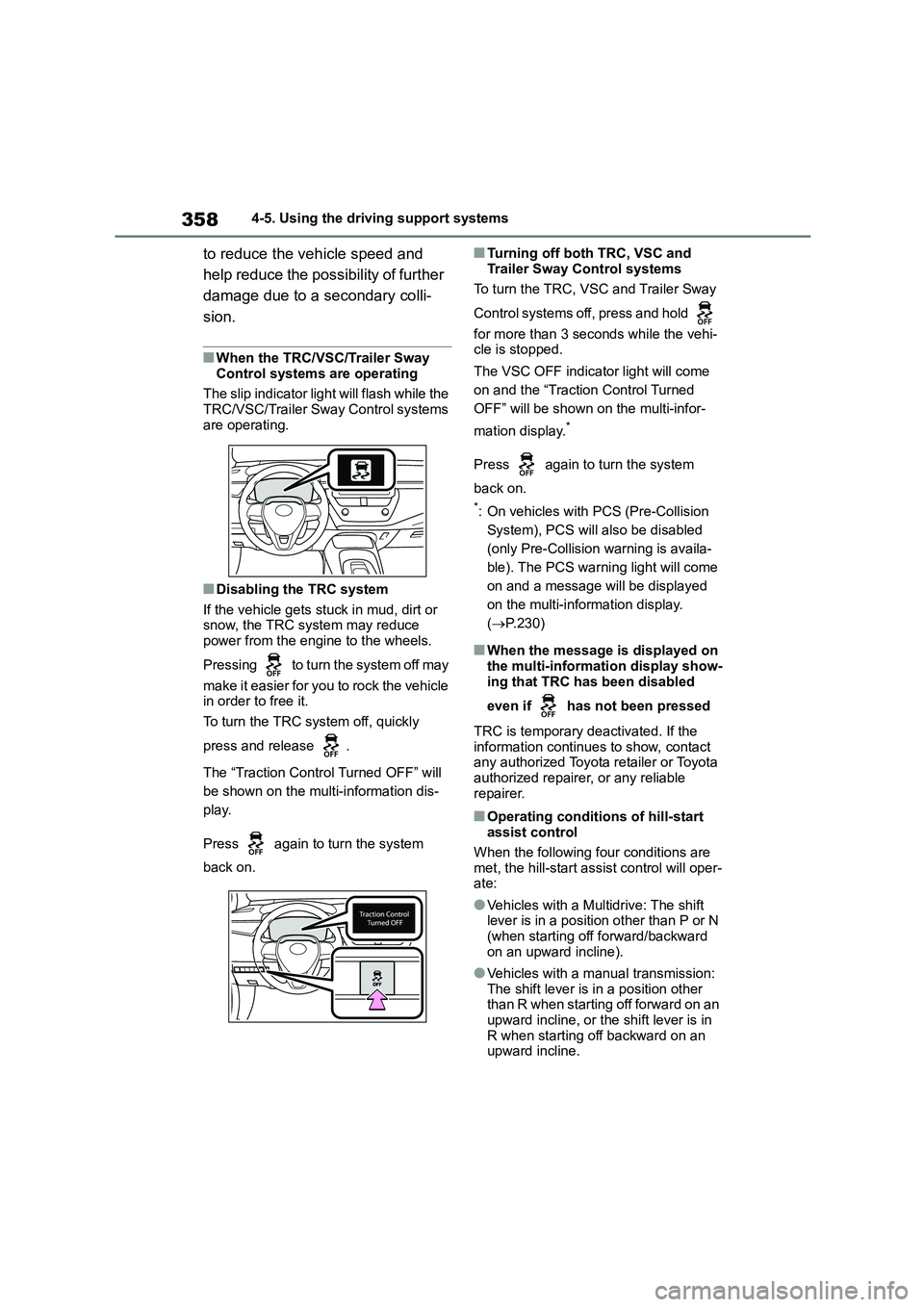
3584-5. Using the driving support systems
to reduce the vehicle speed and
help reduce the poss ibility of further
damage due to a secondary colli-
sion.
■When the TRC/VSC/Trailer Sway
Control systems are operating
The slip indicator light will flash while the
TRC/VSC/Trailer Sway Control systems
are operating.
■Disabling the TRC system
If the vehicle gets stuck in mud, dirt or snow, the TRC system may reduce
power from the engine to the wheels.
Pressing to turn the system off may
make it easier for you to rock the vehicle
in order to free it.
To turn the TRC system off, quickly
press and release .
The “Traction Control Turned OFF” will
be shown on the multi-information dis-
play.
Press again to turn the system
back on.
■Turning off both TRC, VSC and
Trailer Sway Control systems
To turn the TRC, VSC and Trailer Sway
Control systems off, press and hold
for more than 3 seconds while the vehi- cle is stopped.
The VSC OFF indicator light will come
on and the “Traction Control Turned
OFF” will be shown on the multi-infor-
mation display.*
Press again to turn the system
back on.
*: On vehicles with PCS (Pre-Collision
System), PCS will also be disabled
(only Pre-Collision warning is availa-
ble). The PCS warning light will come
on and a message will be displayed
on the multi-information display.
( P.230)
■When the message is displayed on
the multi-information display show- ing that TRC has been disabled
even if has not been pressed
TRC is temporary deactivated. If the information continues to show, contact
any authorized Toyota retailer or Toyota
authorized repairer, or any reliable repairer.
■Operating conditions of hill-start
assist control
When the following four conditions are met, the hill-start assist control will oper-
ate:
●Vehicles with a Multidrive: The shift
lever is in a position other than P or N
(when starting off forward/backward
on an upward incline).
●Vehicles with a manual transmission:
The shift lever is in a position other than R when starting off forward on an
upward incline, or the shift lever is in
R when starting off backward on an upward incline.
Page 361 of 758
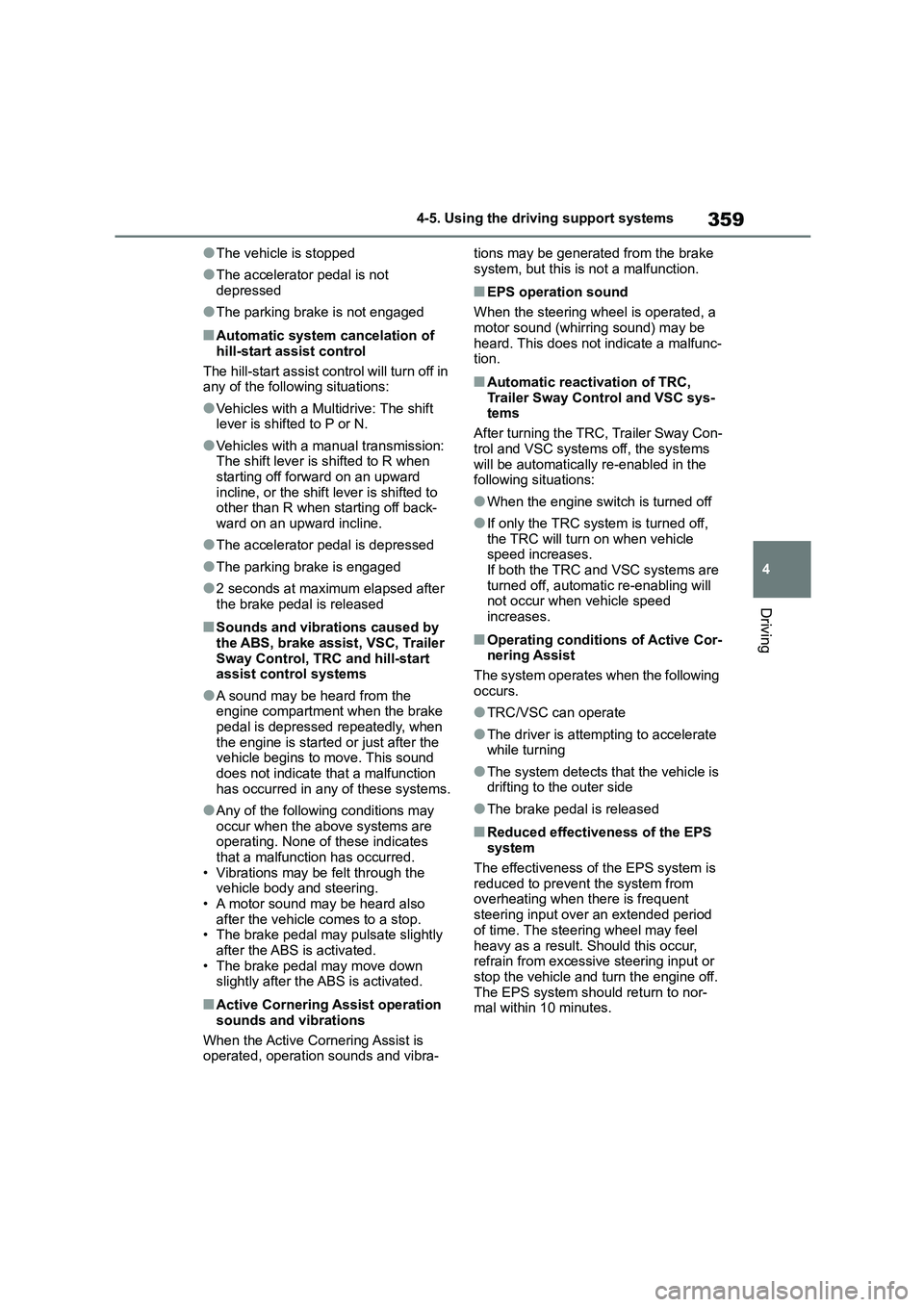
359
4
4-5. Using the driving support systems
Driving
●The vehicle is stopped
●The accelerator pedal is not
depressed
●The parking brake is not engaged
■Automatic system cancelation of
hill-start assist control
The hill-start assist control will turn off in any of the following situations:
●Vehicles with a Multidrive: The shift lever is shifted to P or N.
●Vehicles with a manual transmission: The shift lever is shifted to R when
starting off forward on an upward
incline, or the shift lever is shifted to other than R when starting off back-
ward on an upward incline.
●The accelerator pedal is depressed
●The parking brake is engaged
●2 seconds at maximum elapsed after
the brake pedal is released
■Sounds and vibrations caused by the ABS, brake assist, VSC, Trailer
Sway Control, TRC and hill-start
assist control systems
●A sound may be heard from the
engine compartment when the brake pedal is depressed repeatedly, when
the engine is started or just after the
vehicle begins to move. This sound does not indicate that a malfunction
has occurred in any of these systems.
●Any of the following conditions may
occur when the above systems are
operating. None of these indicates that a malfunction has occurred.
• Vibrations may be felt through the
vehicle body and steering. • A motor sound may be heard also
after the vehicle comes to a stop.
• The brake pedal may pulsate slightly
after the ABS is activated. • The brake pedal may move down
slightly after the ABS is activated.
■Active Cornering Assist operation
sounds and vibrations
When the Active Cornering Assist is
operated, operation sounds and vibra-
tions may be generated from the brake
system, but this is not a malfunction.
■EPS operation sound
When the steering wheel is operated, a
motor sound (whirring sound) may be
heard. This does not indicate a malfunc- tion.
■Automatic reactivation of TRC,
Trailer Sway Control and VSC sys-
tems
After turning the TRC, Trailer Sway Con-
trol and VSC systems off, the systems
will be automatically re-enabled in the following situations:
●When the engine switch is turned off
●If only the TRC system is turned off,
the TRC will turn on when vehicle speed increases.
If both the TRC and VSC systems are
turned off, automatic re-enabling will not occur when vehicle speed
increases.
■Operating conditions of Active Cor-
nering Assist
The system operates when the following
occurs.
●TRC/VSC can operate
●The driver is attempting to accelerate while turning
●The system detects that the vehicle is drifting to the outer side
●The brake pedal is released
■Reduced effectiv eness of the EPS system
The effectiveness of the EPS system is
reduced to prevent the system from overheating when there is frequent
steering input over an extended period
of time. The steering wheel may feel
heavy as a result. Should this occur, refrain from excessive steering input or
stop the vehicle and turn the engine off.
The EPS system should return to nor- mal within 10 minutes.
Page 363 of 758
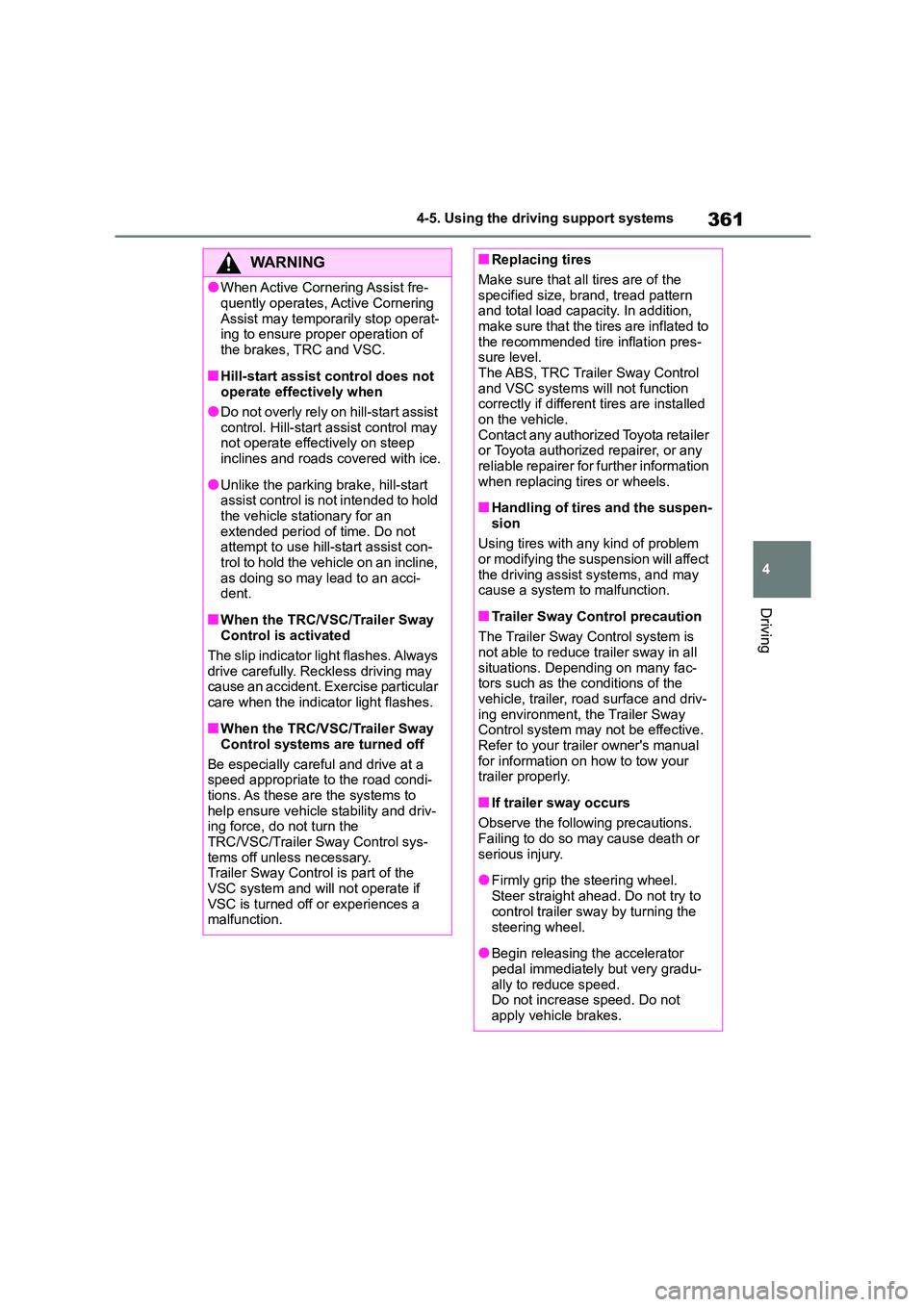
361
4
4-5. Using the driving support systems
Driving
WA R N I N G
●When Active Cornering Assist fre-
quently operates, Active Cornering
Assist may temporarily stop operat- ing to ensure proper operation of
the brakes, TRC and VSC.
■Hill-start assist control does not
operate effectively when
●Do not overly rely on hill-start assist
control. Hill-start assist control may not operate effectively on steep
inclines and roads covered with ice.
●Unlike the parking brake, hill-start
assist control is not intended to hold
the vehicle stationary for an extended period of time. Do not
attempt to use hill-start assist con-
trol to hold the vehicle on an incline, as doing so may lead to an acci-
dent.
■When the TRC/VSC/Trailer Sway
Control is activated
The slip indicator light flashes. Always drive carefully. Reckless driving may
cause an accident. Exercise particular
care when the indicator light flashes.
■When the TRC/VSC/Trailer Sway
Control systems are turned off
Be especially careful and drive at a
speed appropriate to the road condi-
tions. As these are the systems to help ensure vehicle stability and driv-
ing force, do not turn the
TRC/VSC/Trailer Sway Control sys- tems off unless necessary.
Trailer Sway Control is part of the
VSC system and will not operate if VSC is turned off or experiences a
malfunction.
■Replacing tires
Make sure that all tires are of the
specified size, brand, tread pattern
and total load capacity. In addition, make sure that the tires are inflated to
the recommended tire inflation pres-
sure level. The ABS, TRC Trailer Sway Control
and VSC systems w ill not function
correctly if different tires are installed on the vehicle.
Contact any authorized Toyota retailer
or Toyota authorized repairer, or any reliable repairer for further information
when replacing tires or wheels.
■Handling of tires and the suspen-
sion
Using tires with any kind of problem or modifying the suspension will affect
the driving assist systems, and may
cause a system to malfunction.
■Trailer Sway Control precaution
The Trailer Sway Control system is not able to reduce trailer sway in all
situations. Depending on many fac-
tors such as the conditions of the vehicle, trailer, road surface and driv-
ing environment, the Trailer Sway
Control system may not be effective. Refer to your trailer owner's manual
for information on how to tow your
trailer properly.
■If trailer sway occurs
Observe the following precautions. Failing to do so may cause death or
serious injury.
●Firmly grip the steering wheel.
Steer straight ahead. Do not try to
control trailer sway by turning the
steering wheel.
●Begin releasing the accelerator
pedal immediately but very gradu- ally to reduce speed.
Do not increase speed. Do not
apply vehicle brakes.
Page 433 of 758
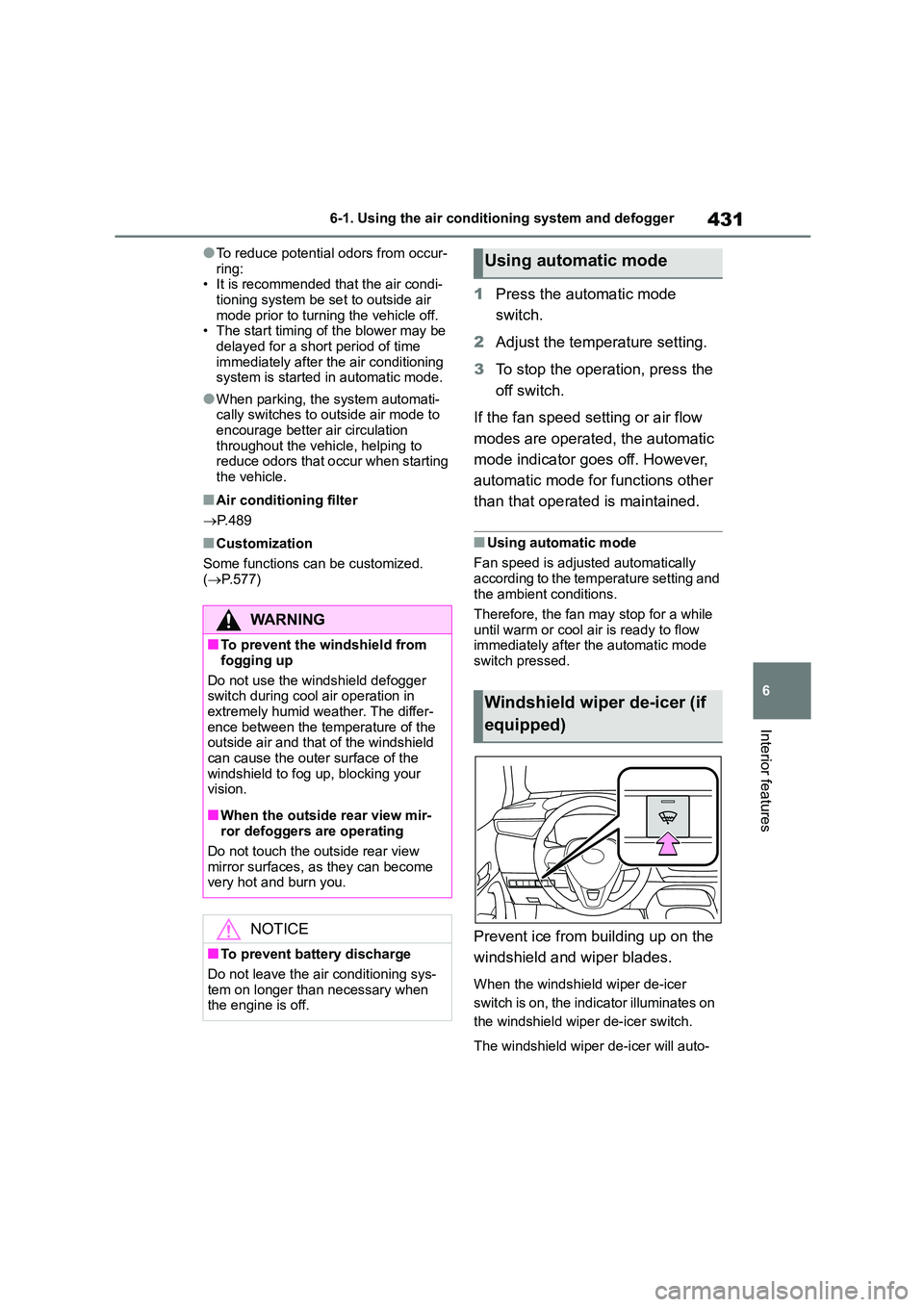
431
6
6-1. Using the air conditioning system and defogger
Interior features
●To reduce potential odors from occur-
ring: • It is recommended that the air condi-
tioning system be se t to outside air
mode prior to turning the vehicle off. • The start timing of the blower may be
delayed for a short period of time
immediately after the air conditioning system is started in automatic mode.
●When parking, the system automati- cally switches to outside air mode to
encourage better air circulation
throughout the vehicle, helping to reduce odors that o ccur when starting
the vehicle.
■Air conditioning filter
P.489
■Customization
Some functions can be customized.
( P.577)
1Press the automatic mode
switch.
2 Adjust the temperature setting.
3 To stop the operation, press the
off switch.
If the fan speed setting or air flow
modes are operated, the automatic
mode indicator goes off. However,
automatic mode fo r functions other
than that operated is maintained.
■Using automatic mode
Fan speed is adjusted automatically
according to the temperature setting and the ambient conditions.
Therefore, the fan may stop for a while
until warm or cool air is ready to flow immediately after the automatic mode
switch pressed.
Prevent ice from building up on the
windshield and wiper blades.
When the windshield wiper de-icer
switch is on, the indicator illuminates on
the windshield wipe r de-icer switch.
The windshield wiper de-icer will auto-
WA R N I N G
■To prevent the windshield from
fogging up
Do not use the windshield defogger
switch during cool air operation in
extremely humid weather. The differ- ence between the temperature of the
outside air and that of the windshield
can cause the outer surface of the windshield to fog up, blocking your
vision.
■When the outside rear view mir-
ror defoggers are operating
Do not touch the outside rear view mirror surfaces, as they can become
very hot and burn you.
NOTICE
■To prevent battery discharge
Do not leave the air conditioning sys-
tem on longer than necessary when
the engine is off.
Using automatic mode
Windshield wiper de-icer (if
equipped)